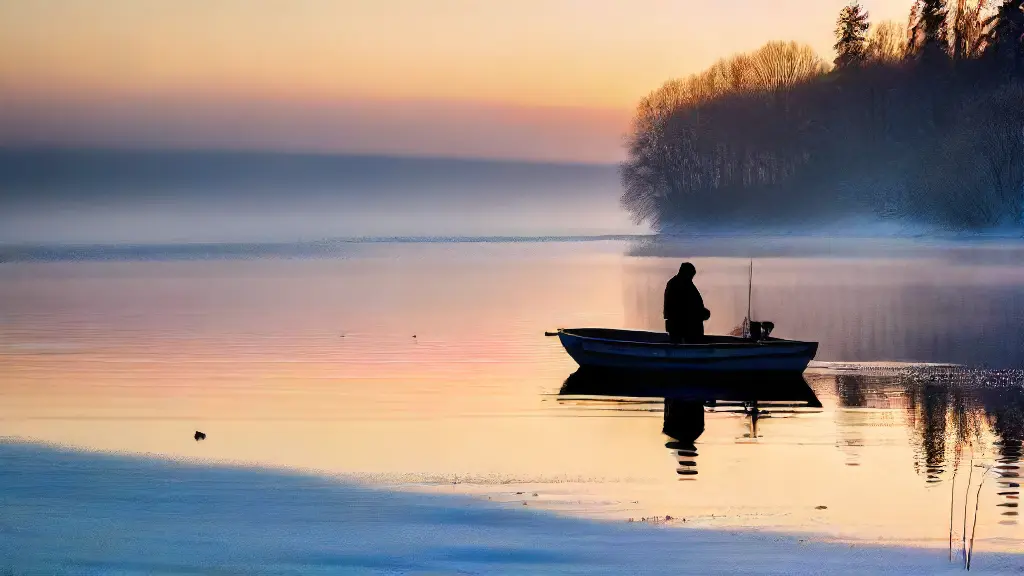Best Ways to Use Bait Fish in Cold Water

As temperatures drop, a clear understanding of bait fish behavior in cold water becomes crucial for angling success. By adapting to the changes that occur in bait fish behavior during low-temperature conditions, anglers can significantly boost their chances of landing a prized catch.
Living in harmony with nature, the best ways to use bait fish in cold water reveal the secrets of successful live bait fishing in low temperature conditions.
By studying bait fish behavior in these conditions, anglers can gain a better understanding of how to effectively present their live bait to attract the attention of target species.
In icy freshwater waterbodies, bait fish behavior undergoes a transformation that affects their movement patterns and feeding habits. For example, bait fish tend to congregate in deeper areas where the water is icy cold.
What Fish Behave Well in Cold Water
In the realm of aquatic life, few phenomena evoke a sense of awe as the ability of certain fish to thrive in frigid conditions, a testament to their remarkable adaptability and resilience.
Temperature Tolerant Fish Species.
-
Fish that thrive in cold water include trout, salmon, and char, which are often found in glaciated regions.
-
Fish that tolerate cold water, such as lake trout, pike, and walleye, are more widespread and can be found in a variety of environments. Minnows, leeches, and worms remain active and responsive to bait in cold water, making them popular choices for ice fishing and other winter fishing techniques using lures and tackle.

How to Choose Effective Baits
As winter’s chill sets in, many anglers struggle to adapt their tactics to the changing fishing dynamics. Hooks and sinkers often become less effective, while subtle adjustments can make all the difference in landing a prized catch.
Winter Fishing Challenges Adjustments for Success Common Mistakes Less Effective Hooks and Sinkers Subtle Adjustments Can Make a Difference Not Adapting to Changing Fishing Dynamics Water Temperature Affects Fish Behavior Slow Down Your Retrieval Speed Using the Same Tactics All Year Fish Migration Patterns Change Use Live Baits and Natural Lures Not Researching Local Fishing Conditions When to Use Live Baits
Finding the right bait to entice finicky fish in cold water conditions. Rigging up the right tackle is crucial, but sometimes it’s the humble live bait that proves most effective.
Why Live Baits Excel in Cold Water
Fish are more active and aggressive in cold water, making it the perfect environment for live baits to shine.Jigging a subtle presentation can be the key to success.
This is because cold water reduces a fish’s metabolism, making them more sluggish and less likely to attack artificial lures. Live baits, on the other hand, provide a natural source of nutrition that fish can’t resist, particularly when water quality is at its best. Pick the Right Live Baits for the Job.
Why Do Fish Slow Down in Cold Water
Amidst the intricate structural complexity of our planet’s water bodies, fish have evolved remarkable adaptations to navigate unpredictable aquatic environments.
I. Introduction
Understanding fish behavior in cold water is essential for anglers, scientists, and conservationists alike.Fish are incredibly resilient creatures, but even they are not immune to the effects of temperature fluctuations.
As the cold water sets in, fish slow down, and their metabolism comes to a grinding halt.
But why does this happen, and what can we learn from it?
II. Physiological Effects
Cold water affects a fish’s metabolism and energy consumption in profound ways.As the temperature drops, a fish’s metabolic rate slows down, requiring less energy to survive. To conserve energy, fish adjust their bodily functions, slowing down their heart rate, reducing muscle activity, and even altering their patterns of aquatic vegetation to avoid hidden aquatichazards and utilize structuralcomplexity in aquaticstructure for habitat and migration purposes, thus ensuring effective fishhabitat, optimal fishmigration, and successful fishbehavior, which ultimately contributes to sustainable fisherymanagement, aquaticconservation, and compliant fishingregulations.
Fish Behavior in Cold Water
- Fish slow down their metabolism and energy consumption in cold water to conserve energy.
- Cold water affects a fish’s metabolic rate, requiring less energy to survive.
- Fish adjust their bodily functions, slowing down their heart rate, reducing muscle activity, and altering their patterns of aquatic vegetation in cold water.
- Understanding fish behavior in cold water is essential for anglers, scientists, and conservationists alike for sustainable fishery management, aquatic conservation, and compliant fishing regulations.
How to Present Baits Naturally
As you cast your line into the water, it’s essential to understand the subtle dance of your bait to entice those elusive fish to bite. Fishing gear in hand, you’re one step closer to reeling in the big catch.
Study the natural movement of the bait by observing how it reacts to water currents and temperature changes.
This will help you identify the bait’s natural swimming pattern and how it responds to different environmental conditions.
Identify the bait’s natural swimming pattern and recognize how bait responds to temperature changes. This knowledge will enable you to present your fishing gear in a way that mimics its natural behavior.
Fishing permits allow you to explore new waters, but it’s your presentation skills that will get you that coveted catch.
Tracking and mimicking bait migration patterns and timing is essential for presenting the bait naturally. Study the migration patterns and timing to identify when and where to purchase fishing licenses, permits, gear, accessories, reels, rods, lines, lures, hooks, sinker, float, and bobbers.
How to Increase Fishing Success
As winter’s chill settles over the lakes and rivers, many anglers struggle to reel in the big ones. The truth is, effective fishing in cold water requires a deep understanding of aquatichabitats and the specific behavior of baitfish in these lowtemperature environments.
Fishing in cold water poses unique challenges, as water temperature plays a significant role in the behavior and metabolism of baitfish.
Understanding how cold water affects baitfishbehaviour is essential for making informed decisions about bait selection and presentation in these aquatic ecosystems.
Cold water has a profound impact on the metabolism and movement of baitfish, causing them to slow down and become less active. Identifying cold-water-adapted baitfish species and understanding their behavior patterns is crucial for successful fishcatching in these aquatic environments. When it comes to effective baits for cold water fishing, live baits are often the most effective.
Cold Water Fishing
- Water temperature plays a significant role in the behavior and metabolism of baitfish.
- Cold water has a profound impact on the metabolism and movement of baitfish, causing them to slow down and become less active.
- Identifying cold-water-adapted baitfish species and understanding their behavior patterns is crucial for successful fishcatching in these aquatic environments.
- Live baits are often the most effective for cold water fishing.
What Fishing Styles Work Best
The thrill of reeling in a big catch is a sensation that has captivated anglers for centuries, and to achieve success, one must master the art of fishing by understanding the intricacies of aquatic habitats and fish reproduction.
Fishing in cold water demands a patient and strategic approach, differing significantly from fishing in warmer waters.
A slow and steady pace allows anglers to wait for fish to take the bait, increasing the chances of a successful catch.
In cold water, live bait is essential for consistent catches, as it provides a natural presentation that is difficult for fish to resist.
Choosing the right bait for the job is crucial, and understanding fishery science plays a significant role in this decision. By selecting the right bait, anglers can increase their chances of landing a big catch.
How to Avoid Wasteful Fishing
The delicate balance of our aquatic ecosystems is often overlooked, yet it’s essential to recognize the profound impact our actions have on the intricate web of life beneath the surface.
Fishingguidance is crucial in this endeavor, as it empowers anglers to adopt sustainable methods that not only conserve resources but also protect fish populations from overexploitation and habitat destruction.
Effective fisheryprotection relies on adhering to local regulations, selecting sustainable bait options, and modifying fishing gear to reduce waste and minimize environmental impact.
AUNCTIONarily, aquaticpreservation is vital, and anglers can play a significant role in this effort by supporting conservation efforts and preserving aquatic ecosystems through responsible practices. Catch-and-release techniques can significantly contribute to fish population management, as they allow for a more sustainable approach to harvesting fish, reducing bycatch, and ultimately promoting fishingguidance for fisheryprotection and fishingpractices supportive of aquaticpreservation, as well as advancing aquaticecology and fishhabitatconservation through fishinggearselection and aquaticstructureconservation informed by fishpopulationdynamics and fishingrecreational and aquaticresearchstudy.
Fishing Guidance Effective Fishery Protection Aquatic Preservation Fish Population Management Empowers anglers to adopt sustainable methods Relies on adhering to local regulations and selecting sustainable bait options Supports conservation efforts and preserves aquatic ecosystems Catch-and-release techniques allow for a more sustainable approach to harvesting fish Conserves resources and protects fish populations from overexploitation and habitat destruction Modifies fishing gear to reduce waste and minimize environmental impact Promotes fishing practices supportive of aquatic preservation Reduces bycatch and promotes sustainable fishing practices How Bait Fish Behavior Changes During Spawning
How Bait Fish Behavior Differs Between Freshwater and Saltwater


